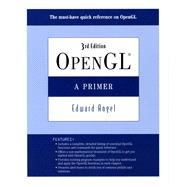
Note: Supplemental materials are not guaranteed with Rental or Used book purchases.
Purchase Benefits
What is included with this book?
| Preface | |
| Introduction | |
| The OpenGL API | |
| What's in OpenGL | |
| OpenGL Versions of Extensions | |
| Languages | |
| Programming Conventions | |
| Compiling | |
| Sources | |
| Who Should Use this Primer | |
| Outline | |
| Two-Dimensional Programming in OpenGL | |
| A Simple Program | |
| GLUT | |
| Event Loops and Callback Functions | |
| Drawing a Rectangle | |
| Changing the GLUT Defaults | |
| Color in OpenGL | |
| Coordinate System Differences Between Gand OpenGL | |
| Two-Dimensional Viewing | |
| The Viewport | |
| Coordinate Systems and Transformations | |
| Simple C, Second Version | |
| Primitives and Attributes | |
| Polygon Types | |
| Color Interpolation | |
| Text | |
| Inquires and Errors | |
| Saving the State | |
| Interaction and Animation | |
| The Reshape Callback | |
| The Idle Callback | |
| A Rotating Square | |
| Double Buffering | |
| Using the Keyboard | |
| Using the Mouse Callback | |
| Mouse Motion | |
| Menus | |
| The NULL Callback | |
| Sub and Multiple Windows | |
| Example: single_double.c | |
| Display Lists | |
| Picking and Selection Mode | |
| Basic Three-Dimensional Programming | |
| Cameras and Objects | |
| Orthographic Projects in OpenGL | |
| Viewing a Cube | |
| Locating the Camera | |
| Building Objects | |
| Hidden Surface Removal | |
| GLU and GLUT Objects | |
| Perspective Projects | |
| Transformations | |
| Line-Preserving Transformations | |
| Homogeneous Coordinates | |
| The Model-View and Projection Transformations | |
| Translation | |
| Rotation | |
| Scaling | |
| A Rotating Cube | |
| Setting Matrices Directly | |
| Transformations and Coordinate Systems | |
| Modeling with Transformations | |
| Lights and Materials | |
| Light/Material Interactions | |
| The Phong Model | |
| OpenGL Lighting | |
| Specifying a Light Source | |
| Specifying a Material | |
| Shading the Rotating Cube | |
| Controlling the Lighting Calculation | |
| Smooth Shading | |
| Working with Normals | |
| Transparency | |
| Images | |
| Pixels and Bitmaps | |
| Bitmaps | |
| Drawing Modes | |
| Reading and Writing Pixels | |
| Selecting Buffers | |
| Pixel Store Modes | |
| Displaying a PPM Image | |
| Using Luminance | |
| Pixel Mapping | |
| Pixel Zoom | |
| Image Processing in OpenGL | |
| Texture Mapping | |
| What is a Texture Map? Constructing a Texture Map | |
| Texture Coordinates | |
| Texture Parameters | |
| A Rotating Cube with Texture | |
| Applying Textures to Surfaces | |
| Borders and Sizing | |
| Mipmaps | |
| Automatic Texture Coordinate Generation | |
| Texture Maps for Image Manipulation | |
| Curves and Surfaces | |
| Parametric Curves | |
| Parametric Surfaces | |
| BFzier Curves and Surfaces | |
| One-Dimensional OpenGL Evaluators | |
| Two-Dimensional Evaluators | |
| An Interactive Example | |
| Other Types of Cures | |
| The Utah Teapot | |
| Normals and Shading | |
| Interpreting Surfaces | |
| Putting It Together | |
| A Demo Program | |
| Other OpenGL Features | |
| Buffers | |
| Writing Portable, Efficient, Robust Code | |
| Looking to the Future | |
| Versions and Extensions | |
| OPenGL Extensions | |
| Going Beyond Real-Time Graphics | |
| Programmable Pipelines | |
| Shading Languages | |
| Index | |
| Table of Contents provided by Publisher. All Rights Reserved. |
The New copy of this book will include any supplemental materials advertised. Please check the title of the book to determine if it should include any access cards, study guides, lab manuals, CDs, etc.
The Used, Rental and eBook copies of this book are not guaranteed to include any supplemental materials. Typically, only the book itself is included. This is true even if the title states it includes any access cards, study guides, lab manuals, CDs, etc.